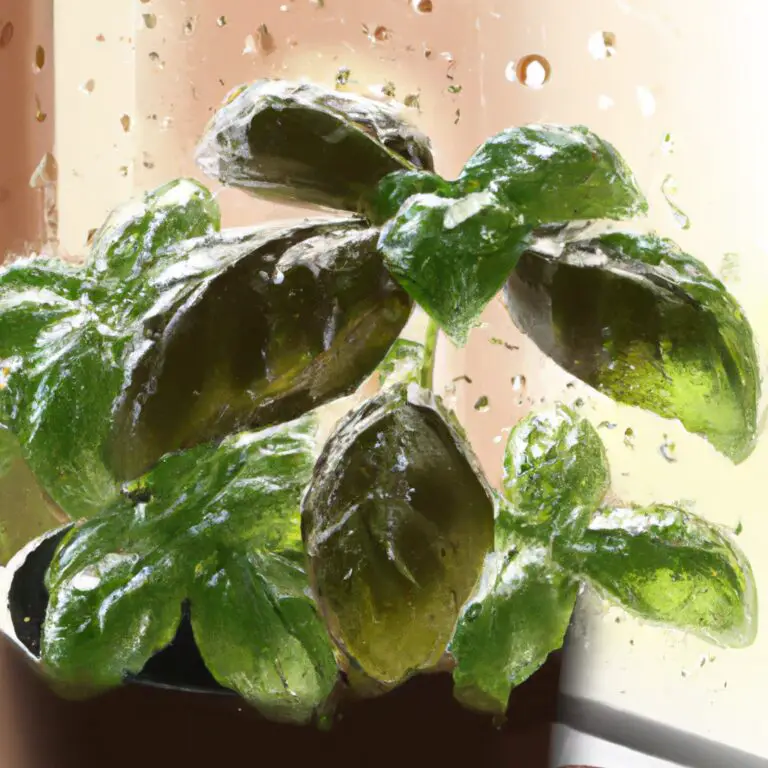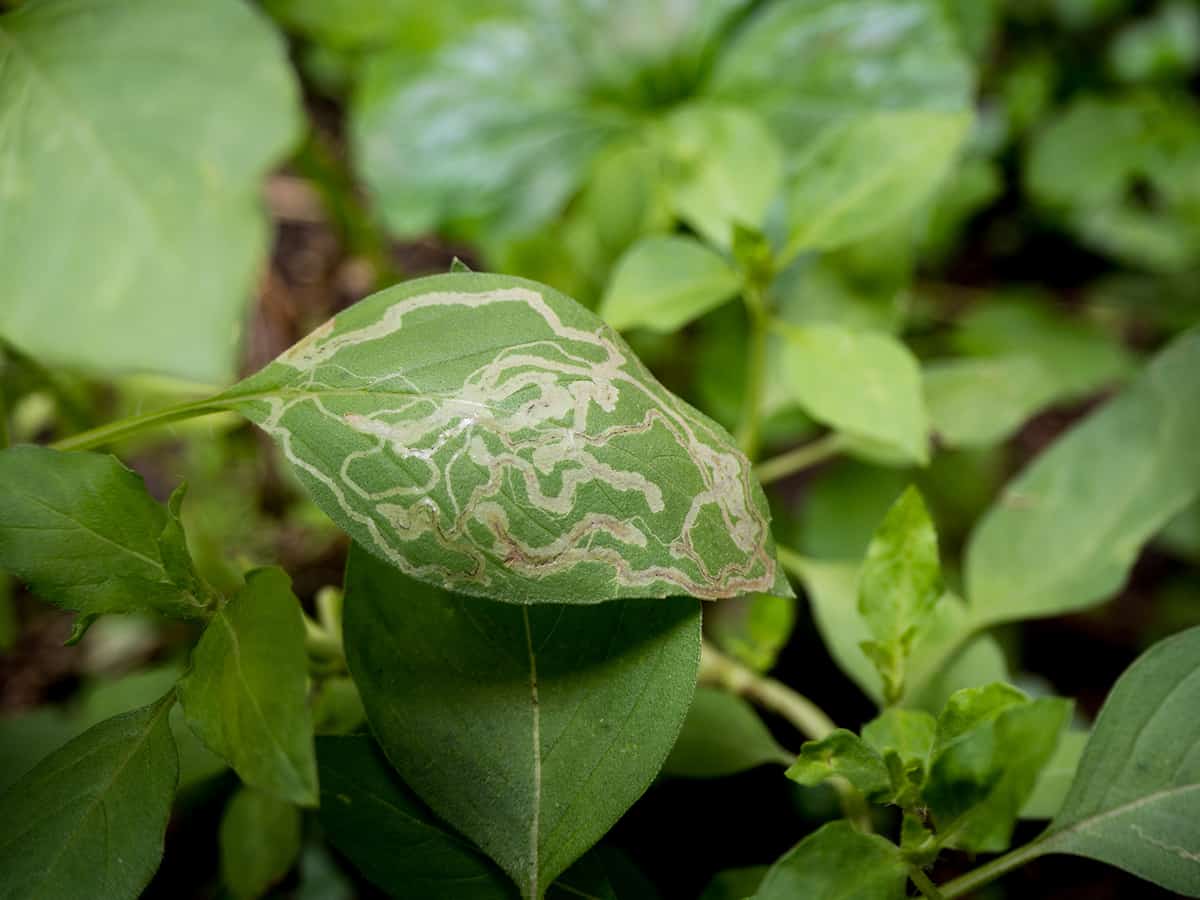Diagnosing the Problem: Why Your Basil Plant May Be Dying
Basil plants can be finicky, and there are several reasons why they may be dying. Overwatering is a common mistake that can lead to root rot and kill the plant. On the other hand, underwatering can cause the leaves to wilt and turn yellow. Pests, diseases, and nutrient deficiencies can also affect the health of your basil plant.
To identify the root cause of the problem, inspect your plant carefully. Check the soil moisture by sticking your finger into the soil up to the first knuckle. If the soil feels dry, it’s time to water. If it’s already moist, wait a day or two before watering again. Look for signs of pests, such as aphids, whiteflies, or spider mites, and treat the plant with insecticidal soap or neem oil if necessary.
Check for diseases, such as powdery mildew or root rot, and treat the plant with a fungicide if necessary. Make sure your basil plant is receiving enough nutrients by using a balanced fertilizer. If you’re still unsure what’s causing the problem, try to revive your basil plant by adjusting its growing conditions. By identifying the root cause of the problem, you can take the necessary steps to revive your basil plant and prevent future problems.
Reviving a dead basil plant requires patience and care. By understanding the common reasons why basil plants die, you can take the necessary steps to prevent these problems and keep your plant healthy and thriving. In the next section, we’ll discuss the importance of pruning and cutting back a dying basil plant to encourage new growth and prevent the spread of disease.
Pruning and Cutting Back: The First Step to Revival
Pruning and cutting back a dying basil plant is a crucial step in reviving it. By removing dead or damaged leaves and stems, you can encourage new growth and prevent the spread of disease. This process also helps to promote healthy air circulation and prevent fungal diseases from taking hold.
To prune your basil plant effectively, start by removing any dead or damaged leaves or stems. Cut back the plant to about one-third to one-half of its original height, making sure to cut just above a node (where a leaf meets the stem). This will help the plant to focus its energy on producing new growth rather than trying to sustain damaged or dying leaves.
Use clean and sharp pruning tools to prevent spreading disease and to make clean cuts. Make sure to disinfect your pruning tools between cuts to prevent the spread of disease. You can also use scissors or pinch off the leaves and stems with your fingers, but be careful not to damage the plant.
After pruning, inspect your plant for any signs of pests or diseases. If you notice any problems, treat the plant accordingly. Pruning and cutting back is an essential step in reviving a dead basil plant, and by doing it correctly, you can help your plant to recover and thrive.
By pruning and cutting back your basil plant, you can help to revive it and encourage new growth. This is an essential step in the process of reviving a dead basil plant, and by following these tips, you can help your plant to recover and thrive. In the next section, we’ll discuss the importance of adjusting watering habits to revive a dying basil plant.
Adjusting Watering Habits: Finding the Right Balance
Proper watering habits are essential for reviving a dying basil plant. Overwatering and underwatering are two of the most common mistakes that can lead to a basil plant’s demise. To revive a dead basil plant, it’s crucial to find the right balance of water.
To check the soil moisture, stick your finger into the soil up to the first knuckle. If the soil feels dry, it’s time to water. If it’s already moist, wait a day or two before watering again. Make sure not to overwater, as this can lead to root rot and other problems.
Water your basil plant in the morning, so the plant has the entire day to absorb the water. Avoid getting water on the leaves to prevent fungal diseases. Instead, water at the base of the plant, allowing the soil to absorb the water.
Adjust your watering habits based on the climate and season. During hot and dry weather, your basil plant may require more frequent watering. During cooler and more humid weather, you may need to water less often.
By adjusting your watering habits and finding the right balance, you can help your basil plant to recover and thrive. Remember, the key is to provide consistent moisture without overwatering or underwatering. In the next section, we’ll discuss the importance of providing optimal growing conditions for your basil plant.
Providing Optimal Growing Conditions: Temperature, Humidity, and Light
Basil plants require specific growing conditions to thrive. Temperature, humidity, and light are essential factors to consider when reviving a dead basil plant. By providing optimal growing conditions, you can help your basil plant to recover and grow.
Temperature is a critical factor in basil plant growth. Basil plants prefer warm temperatures between 60°F and 80°F (15°C and 27°C). Avoid placing your basil plant near drafts or extreme temperatures, as this can cause stress and slow down growth.
Humidity is also important for basil plants. Basil plants prefer a humid environment, typically above 50%. You can increase the humidity around your basil plant by placing the pot on a tray filled with water and pebbles or using a humidifier.
Light is essential for basil plant growth. Basil plants require bright, indirect light to photosynthesize and grow. Placing your basil plant near a sunny window or using grow lights can provide the necessary light for growth.
By providing optimal growing conditions, you can help your basil plant to recover and grow. Make sure to monitor the temperature, humidity, and light levels around your basil plant and adjust as necessary. In the next section, we’ll discuss the importance of fertilizing and repotting a dying basil plant.
Fertilizing and Repotting: Giving Your Basil Plant a Boost
Fertilizing and repotting a dying basil plant can provide essential nutrients and a fresh start. Basil plants require a balanced fertilizer that is high in nitrogen, phosphorus, and potassium. Look for a fertilizer that is specifically formulated for herbs and follow the instructions on the label.
When choosing a fertilizer, consider the type of basil plant you have. Sweet basil, for example, requires a fertilizer that is high in nitrogen, while Thai basil requires a fertilizer that is high in phosphorus.
Repotting a dying basil plant can also provide a fresh start. Choose a pot that is slightly larger than the original pot and use a well-draining potting mix. This will help to prevent waterlogged soil and root rot.
When repotting, gently remove the basil plant from its pot and inspect the roots. If the roots are circling or growing out of the pot, trim them back to encourage new growth. Place the basil plant in its new pot and water thoroughly.
By fertilizing and repotting a dying basil plant, you can provide the necessary nutrients and a fresh start for the plant to recover and thrive. In the next section, we’ll discuss common pests and diseases that can affect basil plants and how to manage them.
Pest and Disease Management: Common Problems and Solutions
Basil plants can be susceptible to pests and diseases, which can further weaken a dying plant. Common pests that can affect basil plants include aphids, whiteflies, and spider mites. These pests can be managed by using insecticidal soap or neem oil.
Diseases such as powdery mildew, root rot, and leaf spot can also affect basil plants. Powdery mildew can be managed by removing infected leaves and improving air circulation around the plant. Root rot can be managed by repotting the plant in fresh, well-draining soil. Leaf spot can be managed by removing infected leaves and treating the plant with a fungicide.
Preventing pest and disease problems is key to keeping your basil plant healthy. Make sure to inspect your plant regularly for signs of pests or diseases, and take action immediately if you notice any problems.
Some common signs of pest or disease problems include yellowing or dropping leaves, white powdery patches on the leaves, or black spots on the leaves or stems. If you notice any of these signs, take action immediately to prevent the problem from spreading.
By managing pest and disease problems, you can help to revive a dying basil plant and prevent future problems. In the next section, we’ll discuss the importance of monitoring a revived basil plant’s progress and preventing future problems.
Monitoring Progress and Preventing Future Problems
Once you’ve revived your basil plant, it’s essential to monitor its progress and prevent future problems. Regularly inspect your plant for signs of pests, diseases, or nutrient deficiencies, and take action immediately if you notice any issues.
Check the soil moisture regularly to ensure that the plant is receiving the right amount of water. Adjust your watering habits as needed to prevent overwatering or underwatering.
Provide your basil plant with optimal growing conditions, including temperature, humidity, and light. Make sure to fertilize your plant regularly to provide essential nutrients.
Prune your basil plant regularly to encourage new growth and prevent the spread of disease. Remove any dead or damaged leaves or stems to prevent the spread of disease.
By monitoring your basil plant’s progress and preventing future problems, you can help to keep it healthy and thriving. Remember, reviving a dead basil plant requires patience and care, but with the right techniques and attention, you can bring your plant back to life.
Conclusion: Reviving a Dead Basil Plant Requires Patience and Care
Reviving a dead basil plant requires patience, care, and attention to detail. By following the steps outlined in this article, you can help to bring your basil plant back to life and prevent future problems.
Remember to diagnose the problem, prune and cut back the plant, adjust watering habits, provide optimal growing conditions, fertilize and repot, manage pests and diseases, and monitor progress to prevent future problems.
Reviving a dead basil plant is not a quick fix, but with the right techniques and attention, you can help to restore your plant to its former glory. Don’t be discouraged if your plant doesn’t recover immediately – with time and care, it can thrive once again.
By following these steps and tips, you can learn how to revive a dead basil plant and keep it healthy and thriving. Share your own experiences and tips in the comments below, and happy gardening!







